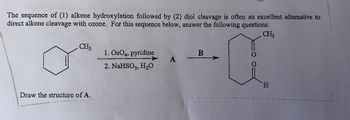
Chemistry
10th Edition
ISBN: 9781305957404
Author: Steven S. Zumdahl, Susan A. Zumdahl, Donald J. DeCoste
Publisher: Cengage Learning
expand_more
expand_more
format_list_bulleted
Question

Transcribed Image Text:**Alkene Hydroxylation and Diol Cleavage Sequence**
The sequence of (1) alkene hydroxylation followed by (2) diol cleavage is often an excellent alternative to direct alkene cleavage with ozone. For this sequence below, answer the following questions.
**Reaction Sequence:**
1. **Reagents Used:**
- *Step 1:* OsO₄ (osmium tetroxide), pyridine
- *Step 2:* NaHSO₃ (sodium bisulfite), H₂O (water)
**Chemical Reaction:**
The starting material is a cyclohexene ring with a methyl group attached, indicated by the structure with a single double bond between two of the carbon atoms.
- The first step involves the addition of osmium tetroxide and pyridine, which typically results in the formation of a diol by adding hydroxyl groups to the carbons involved in the double bond.
- The second step uses sodium bisulfite in the presence of water for cleaving the diol, which typically leads to the formation of ketones or aldehydes.
**Product Formation:**
- The product shown as compound B is a keto-aldehyde, indicating that the oxidative cleavage of the diol has resulted in the formation of these functional groups. The structure retains the cyclohexane ring with a CH₃ group, and two adjacent carbonyl compounds formed where the original double bond was, with one of them being an aldehyde.
**Exercise:**
- Draw the structure of compound A, which is the intermediate formed after the alkene hydroxylation but before the diol cleavage step.
**Note:**
Understanding the transformation from the alkene through hydroxylation to cleavage products is crucial in organic synthesis, offering an alternative to ozonolysis for achieving similar transformations with potential advantages in selectivity and yield.
Expert Solution
This question has been solved!
Explore an expertly crafted, step-by-step solution for a thorough understanding of key concepts.
This is a popular solution
Trending nowThis is a popular solution!
Step by stepSolved in 2 steps with 1 images

Knowledge Booster
Learn more about
Need a deep-dive on the concept behind this application? Look no further. Learn more about this topic, chemistry and related others by exploring similar questions and additional content below.Similar questions
- Question 6arrow_forward20:24 : E) 03 12. Fill in the box with the major organic product of the first step of the reaction shown? The first step of the reaction shown is an exhaustive methylation and is one of the SN2, SN1, E2, or E1 reactions. Another piece of information about this full reaction, the second step proceeds via an E2 mechanism. xs CH₂l 120, A 13. What is the name of the reaction in the previous question? A) Swern Oxidation B) Hofmann Elimination Cope Elimination Williamson Ether Synthesis Exam 1, Stage I 4 Send a chat Oarrow_forwardNeed help!arrow_forward
- Question 19 Select the major product of the reaction sequence below. ОСН-CH, 1. NaOEVEIOH OCH,CH, 2. H3O* OCH,CH,arrow_forward36) [ saturated / unsaturated ] alkane-like carbon compound. are known as compounds with the -OH group attached to an otherwise 37) The the >[ hydroxyl / oxonium / peroxy acid ] group primarily on the less substituted carbon. -catalyzed ring opening of an epoxide that has a tertiary carbon leads to formation of 38) If CH3CH2BR and an [ addition / elimination / oxidation ] reaction with a carbony! group. are reacted in pure ether, the resulting Grignard reagent can be used in 39) Assuming all structures below are planar, circle only the aromatic compounds (+1 or -1 per structure HOH 40) In terms of energy: a) Antiaromatic compounds are [ lower/ higher / identical ] to the corresponding open chain form with an equal number of carbons andarrow_forwardhelp; please DRAW IT; don't answer in text. thanks the reactions are all covered in Organic Chemistry, 6th Edition by Marc Loudon and Jim Parise. Chapter 15-17arrow_forward
- 20:24 : E) 03 12. Fill in the box with the major organic product of the first step of the reaction shown? The first step of the reaction shown is an exhaustive methylation and is one of the SN2, SN1, E2, or E1 reactions. Another piece of information about this full reaction, the second step proceeds via an E2 mechanism. xs CH₂l 120, A 13. What is the name of the reaction in the previous question? A) Swern Oxidation B) Hofmann Elimination Cope Elimination Williamson Ether Synthesis Exam 1, Stage I 4 Send a chat Oarrow_forwardplease helparrow_forwardplease help with allarrow_forward
arrow_back_ios
arrow_forward_ios
Recommended textbooks for you
 ChemistryChemistryISBN:9781305957404Author:Steven S. Zumdahl, Susan A. Zumdahl, Donald J. DeCostePublisher:Cengage Learning
ChemistryChemistryISBN:9781305957404Author:Steven S. Zumdahl, Susan A. Zumdahl, Donald J. DeCostePublisher:Cengage Learning ChemistryChemistryISBN:9781259911156Author:Raymond Chang Dr., Jason Overby ProfessorPublisher:McGraw-Hill Education
ChemistryChemistryISBN:9781259911156Author:Raymond Chang Dr., Jason Overby ProfessorPublisher:McGraw-Hill Education Principles of Instrumental AnalysisChemistryISBN:9781305577213Author:Douglas A. Skoog, F. James Holler, Stanley R. CrouchPublisher:Cengage Learning
Principles of Instrumental AnalysisChemistryISBN:9781305577213Author:Douglas A. Skoog, F. James Holler, Stanley R. CrouchPublisher:Cengage Learning Organic ChemistryChemistryISBN:9780078021558Author:Janice Gorzynski Smith Dr.Publisher:McGraw-Hill Education
Organic ChemistryChemistryISBN:9780078021558Author:Janice Gorzynski Smith Dr.Publisher:McGraw-Hill Education Chemistry: Principles and ReactionsChemistryISBN:9781305079373Author:William L. Masterton, Cecile N. HurleyPublisher:Cengage Learning
Chemistry: Principles and ReactionsChemistryISBN:9781305079373Author:William L. Masterton, Cecile N. HurleyPublisher:Cengage Learning Elementary Principles of Chemical Processes, Bind...ChemistryISBN:9781118431221Author:Richard M. Felder, Ronald W. Rousseau, Lisa G. BullardPublisher:WILEY
Elementary Principles of Chemical Processes, Bind...ChemistryISBN:9781118431221Author:Richard M. Felder, Ronald W. Rousseau, Lisa G. BullardPublisher:WILEY

Chemistry
Chemistry
ISBN:9781305957404
Author:Steven S. Zumdahl, Susan A. Zumdahl, Donald J. DeCoste
Publisher:Cengage Learning

Chemistry
Chemistry
ISBN:9781259911156
Author:Raymond Chang Dr., Jason Overby Professor
Publisher:McGraw-Hill Education

Principles of Instrumental Analysis
Chemistry
ISBN:9781305577213
Author:Douglas A. Skoog, F. James Holler, Stanley R. Crouch
Publisher:Cengage Learning

Organic Chemistry
Chemistry
ISBN:9780078021558
Author:Janice Gorzynski Smith Dr.
Publisher:McGraw-Hill Education

Chemistry: Principles and Reactions
Chemistry
ISBN:9781305079373
Author:William L. Masterton, Cecile N. Hurley
Publisher:Cengage Learning

Elementary Principles of Chemical Processes, Bind...
Chemistry
ISBN:9781118431221
Author:Richard M. Felder, Ronald W. Rousseau, Lisa G. Bullard
Publisher:WILEY